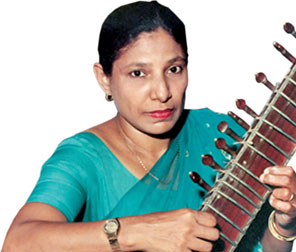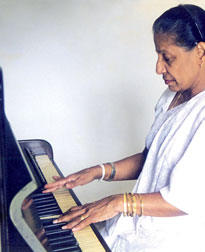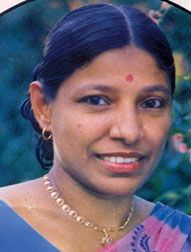Fusion of academic and technical adroitness with aesthetic splendour
An analysis on the performance of a musical genius:
Comparative ideology and vocal creativity
By Ranga CHANDRARATHNE
 Sujatha Attanayake's seminal career in music could be analysed
according to the theory of comparative ideology. Comparative ideology in
creating art is the application of comparative theory by a creative
artiste. Sujatha Attanayake's seminal career in music could be analysed
according to the theory of comparative ideology. Comparative ideology in
creating art is the application of comparative theory by a creative
artiste.
Apart from employing diverse techniques such as Gamak, Tan, Meend,
and singing styles such as Khayal, Dhruvpad, Tarana and Dhamar that
measure their conceptual and expressive values, the guiding philosophy
of the ingenuity of Sujatha's artistry, is the application of
comparative ideology.
In my previous article on Sujatha Attanayake entitled 'Peerless voice
that carries into eternity'
(http://www.sundayobserver.lk/2011/12/04/mon01.asp), appeared on
December 4, 2011 in Montage, the Cultural Paradigm of The Sunday
Observer, I have extensively dealt with diverse techniques Sujatha
employs in singing.
One of the prominent characteristics of applying comparative ideology
and vocal creativity is to distinguish one tradition of music, specific
styles, and techniques from other traditions of music and their
corresponding styles, by not blending them all together.
When Sujatha sings in Tamil, she does not hint of the slightest
Sinhalese influence, and when she sings a song in the North Indian
classical music tradition, she is not influenced by South Indian or the
Carnatic tradition of music although she is an expert in both. In
rendering her voice to songs such as Bolan podi Nangi Tikkak Hitapan
which is based on Sinhala folk music, she deviates from all the major
traditions of music, and represents the authentic Sri Lankan female folk
voice.A successful creation can be made by maintaining or controlling
the conceptual value and expressive value of diverse music sources, and
using them comparatively to achieve the desired objectives.
This process would automatically happen in a highly talented creator
or a musician. The efficacy of the process is dependent on the quantity
and the quality of the creator's or musician's imaginative virtue or
imaginative intelligence. The value of a creation would be determined by
this psychological process and its nature. Manifestation of comparative
ideology is a psychological process that leads to meaningful art.
 The complex psychological process which is very much a conscious
process, is also automatic when it comes to naturally talented singers
such as Sujatha Attanayake. It is a combination of signals from the
nervous system that help to produce intricate musical notes and
interpretive decisions on whether to apply a particular technique in
measuring up its comparative and expressive value, all this within
seconds. The complex psychological process which is very much a conscious
process, is also automatic when it comes to naturally talented singers
such as Sujatha Attanayake. It is a combination of signals from the
nervous system that help to produce intricate musical notes and
interpretive decisions on whether to apply a particular technique in
measuring up its comparative and expressive value, all this within
seconds.
The identification of diverse visions behind different traditions of
music is also helped in the employment of comparative ideology. I have
mentioned in my previous article, “Sujatha excelled in diverse areas in
music she ventured into, in general, and stands out as a singer in
particular. Compared with versatile Indian classical singers in North
Indian and South Indian Carnatic traditions, Sujatha is the only Sri
Lankan singer with a tonal range of voice as wide as those of Indian
classical singers’.
She has the best tutored voice among the Sri Lankan singers. For
instance, Sujatha Attanayake can sing diverse notes on a three octave
scale beginning on Concert C. (Lower Octave, Middle Octave and Higher
Octave). She could sing up to eight notes on the Higher Octave on the
Concert C. In the same manner, she could sing up to 5-6 notes on the
Lower Octave on Concert C.”
Vision of diverse music traditions are different as well as their
defining characters. For instance, in North Indian Classical Music, the
hallmark of the tradition is the enormous freedom enjoyed by the
creative performer. The rudimentary building blocks of the tradition are
Ragaas with much room for improvisation.
A prominent characteristic of North Indian Classical Music is the
Monophonic Melodic Line. In a composition, music would gradually reach
its zenith generating excitement, emotions and deep musical perceptions.
Malodic Line
A prominent characteristic of South Indian music or Carnatic music,
is its compositions take on a more definite form, and the vision of
South Indian music is built up on originality and definite and strict
static concepts. The vision of Western classical music is largely based
on the twin pillars of harmony and counterpoint holding up a melodic
motif.
Comparative ideology in creations
It is obvious that a musician’s or creator’s music perceptions and
the very idea for a creation emerges out of comparative ideology
measuring up diverse musical motifs from diverse sources of music to
suit the creation.
The comparative ideology will help musician to achieve his creative
objectives in a successful manner. Among the factors that determines the
quality and degree to which the comparative ideology is applied, are a
musician’s knowledge, experience, and the understanding of ethno music
and semi organised musical traditions.
The manifestation or non manifestation of music sources in a work of
art made through imaginative virtue or imaginative intelligence is also
vital.
Sujatha Attanayake, who is Sri Lanka's first ever female film music
director/composer, stands out as an object lesson for a gifted musician
who applies comparative ideology in directing and composing music.
Comparative ideology in applied music
In applied music, the successful application of comparative ideology
depends on the above factors, and the success of a musical creation
would depend on its application to achieve creative objectives.
Naturally, the creator would endeavor to make the work as meaningful as
possible.
In actuality, what the listeners would experience as creative or
applied music is the musician’s vision on comparative ideology.
Comparative ideology is born out of music perceptions on the part of the
musician or creator.
The nature of the creator’s comparative ideology is determined on
many factors such as the creator’s place of birth, the environment in
which he or she is raised in, music education, cultural character,
attitudes, perception of culture, knowledge and attitude towards foreign
systems of music.
Sujatha Attanayake’s music perception is made up from the influence
of diverse traditions of music and geographical zones (For a long period
of time Sujatha lived in the United States). Since she has mastered
major music traditions such as North Indian classical music and South
Indian classical music, her comparative ideology is extremely rich.
|

Sujatha Attanayake |
For instance, the song Chanchala Nupura kinkini jaale in the film
Hithaka pipunu mal (she sang the same song in Tamil, Vennil olikkum
Iyarkain Naadam, in the same movie), songs in the Indian movie
Wasawadatta which is dubbed in Sinhala, and in her duet ‘Kottakelingei
Thambala Kannata Dunna’ which she sang with Dr.Victor Ratnayake, she
mimics the voice motifs of a Tamil girl singing the song in Carnatic
tradition.
Significantly, the Carnatic tradition of music is entirely different
to Hindustani tradition and in fact, there are few singers who had
mastered both traditions.
Mastery of traditions which are on the extreme end of the spectrum
can be explained in terms of application of comparative ideology in
creative domain with vocal creativity. Vocal creativity is a salient
attribute of Sujatha Attanayake.
It is due to her sheer vocal creativity that she is able to sing
songs in diverse traditions of music and such a different array of
languages such as Sinhala, Tamil, Hindi, Nepali, Marati, Urdu and
Bengali.
Pure notes
Her ability to produce pure notes can be described in terms of
Imaginative Music or Manodharma Sangeet. As in the case of comparative
ideology, music perceptions are born in the mind and would convert into
signals in the nervous system that would reproduce such music through
vocal codes.
It is through a complex psychological and physical process that
Sujatha generates intricate notes. Her unique vocal code which can
produce intricate microtonal intervals effortlessly is complemented by
her knowledge and practice. For instance, in the song, ‘Kottakelingei
Thambala Kannata Dunna’ the Tamil-texture of her voice is not generated
through the mispronunciation of Sinhalese words but through finer
features of Carnatic music.
She pronounced Sinhalese words perfectly yet with a Tamil texture
generated by the Carnatic music motifs. Another fact which facilitates
her singing in Carnatic tradition is her mastery of several languages
such as Hindi, Tamil, Nepali, Marati, Urdu and Bengali.
Sujatha Attanayake and comparative ideology
The conceptual value and expressive value of a system of music is
determined on Notes, Rhythmic cycles, Rhythm and Music compositions.
A significant aspect of Sujtha Attanayake’s singing is that she has
established conceptual value and expressive value in her singing due to
her mastery of major traditions of music such as North Indian and South
Indian music and one can observe that how she apply comparative ideology
in rendering her voice to songs.
In other words, when she sings, her voice generates appropriate notes
through a complex psychological process which involves the application
of comparative ideology. Although one may be cynical about such a
process ever happen in singing, it is very much applicable to Sujatha’s
singing as she would naturally apply her vast knowledge, practice and
experience in rendering her voice.
However, these concepts such as conceptual value and expressive value
and the comparative ideology can be applicable to only a very few
vocalists in Sri Lanka. Sujatha Attanayake’s career in music is an
example for the application of comparative ideology in diverse domains.
Her contribution to Sinhala culture
Prof. Wimal Dissanayke writing on her contribution to the Sri Lankan
popular culture states, “ Like Dr. Amaradeva before her, Attanayake was
keen to create a popular tradition of music that combined the essence of
all three – folk, classical and popular - while not falling victim to
the trivialities, debasements and vulgarisations of taste associated
with popular mass musical culture.
In other words she was able to draw on the riches of the classical
and folk traditions while taking advantage of the resources made
available by popular mass culture.
When we examine Sujatha Attanayake’s songs and musical compositions
this fact becomes evident. It is her considered judgment that we do not
have the luxury of retreating into a golden past, and insulate ourselves
from all Western influences.
That is not a realistic option. Instead, what she advocates is a
realistic and forward-looking blending of the classical, folk and
popular traditions so as to create a vibrant Sinhala musical culture
that appeals to the people at large while not yielding to crass
commercialism and the concomitant vulgarisation of musical sensibility.”
One of the major areas Sujatha contributed to enrich popular music
culture is film music. She is an outstanding playback singer. Her songs
have immortalised those films, capturing the imagination of the viewers.
For instance, the theme song of the film Parasatumal, Paraunua
Malwala Suwanda Atheethe has not only became an all-time hit but also
became a part of the musical legacy of the nation.Beginning with her
first ever playback song which she sang for S.M. Nayagam’s film Sohoyuro
in 1956, she rendered her voice to over 350 playback songs. She became
the first Sri Lankan woman director of music when she directed music for
the film Hariyata Hari.
Even in her playback singing, one can apply the theory of Imaginative
Music (Manodharma Sangeet). One of the facts that made her playback
singing an integral part of a film, was her ability to render the movie
its defining character. A great number of her songs went on to become
all time favourites, not all that surprising, as her unique voice and
musical intelligence stirred the heart strings of the nation.
*********************
[Jeewana Wila Meda concert]
Sujatha Attanayake, Sri Lankan singer with the widest tonal range and
who can sing in more than five languages including Hindi and Tamil will
hold a solo concert after 20 years. Jeewana Wila Meda will be held at
the Nelum Pokuna, Mahinda Rajapaksa Performing Arts Theatre on May 18 at
6.30 p.m.Munchee is the sole sponsor of the concert.
*********************** |

